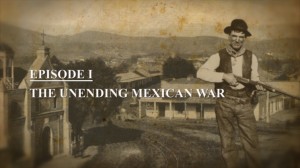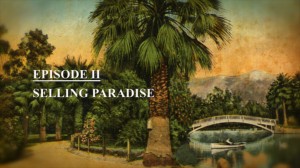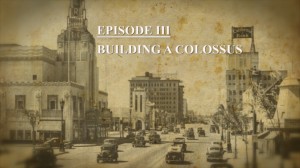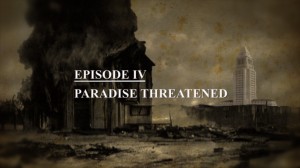In the length of only one human lifetime, El pueblo de la Reina de Los Angeles was transformed from a small frontier outpost in the distant Mexican territory of Alta California into the biggest and most important city in the western half of the United States – and influential around the world. How did this happen? What were the unique circumstances and who were the remarkable and diverse people creating the phenomenon called Los Angeles? Whitewashed Adobe: The Rise of Los Angeles, a groundbreaking four-episode public television documentary series and multi-platform project, reveals surprising and fascinating answers to these questions.
The Episodes: Like tapestries or murals in motion, the episodes of Whitewashed Adobe: The Rise of Los Angeles portray the city’s pivotal historical events, people and processes in vivid and dramatic brush strokes, but they also spotlight in finer detail the achievements and struggles of a diverse and multi-ethnic selection of individuals and groups who played crucial roles in the saga of the city’s ascent. The television episodes – and coordinated multi-platform components – while based in groupings of decades from 1850 until 1950, chronicle the city’s rise through the prism of four key perspectives:
 “Episode One – The Unending Mexican War” portrays the sudden, troubled and even violent transformation of Spanish-Mexican Los Angeles (and California and the Southwest) through massive U.S. territorial gains won through the xenophobic and racially charged War with Mexico of 1846-48, and the resulting demographic, economic and social upheavals triggered by the California Gold Rush and Statehood. The tranquil and pleasant Mexican village of Los Angeles quickly became overwhelmed with newcomers who were often broke and disillusioned gold seekers, or cut throat criminals escaping the law. For decades Los Angeles was one of the most dismal and violent places on earth – daily murders, racially based lynchings, public whippings, culminating in a terrible massacre of innocent Chinese immigrants… The arrival of transcontinental train service to Los Angeles radically transformed the town once again, diminishing the violence, spurring the local economy through tourism, agricultural and industrial investments and a series of spectacular real estate booms that brought hundreds of thousands of new residents and changed Los Angeles into the biggest metropolis on the west coast.
“Episode One – The Unending Mexican War” portrays the sudden, troubled and even violent transformation of Spanish-Mexican Los Angeles (and California and the Southwest) through massive U.S. territorial gains won through the xenophobic and racially charged War with Mexico of 1846-48, and the resulting demographic, economic and social upheavals triggered by the California Gold Rush and Statehood. The tranquil and pleasant Mexican village of Los Angeles quickly became overwhelmed with newcomers who were often broke and disillusioned gold seekers, or cut throat criminals escaping the law. For decades Los Angeles was one of the most dismal and violent places on earth – daily murders, racially based lynchings, public whippings, culminating in a terrible massacre of innocent Chinese immigrants… The arrival of transcontinental train service to Los Angeles radically transformed the town once again, diminishing the violence, spurring the local economy through tourism, agricultural and industrial investments and a series of spectacular real estate booms that brought hundreds of thousands of new residents and changed Los Angeles into the biggest metropolis on the west coast.
 “Episode Two – Selling Paradise” focuses on the wildly successful and decades-long public relations campaign that sold Los Angeles and Southern California as an irresistible paradise of healthfulness and opportunity to the nation (and world). This ingenious salesmanship exploited Los Angeles’ mild climate and sunshine, and built upon romantic and stereotypical depictions of Los Angeles’ minorities and their cultures to create a local and regional history which was commercially profitable and that rooted Los Angeles’ tides of newcomers to their adopted home. La Fiesta de Los Angeles – a spectacular annual celebration of the ethnic diversity of the city brought thousands more visitors and settlers to the city; John Steven McGroarty’s magnificent and massive Mission Play, became the longest-running stage production in U.S. history, and employed real Native Americans and Mexican American performers, breaking racial barriers and giving white audiences a comfortable way to embrace ethnic diversity. These cultural events made Los Angeles more famous and profitable; but they also cemented confining or demeaning ethnic stereotypes that haunted Los Angeles for generations to come.
“Episode Two – Selling Paradise” focuses on the wildly successful and decades-long public relations campaign that sold Los Angeles and Southern California as an irresistible paradise of healthfulness and opportunity to the nation (and world). This ingenious salesmanship exploited Los Angeles’ mild climate and sunshine, and built upon romantic and stereotypical depictions of Los Angeles’ minorities and their cultures to create a local and regional history which was commercially profitable and that rooted Los Angeles’ tides of newcomers to their adopted home. La Fiesta de Los Angeles – a spectacular annual celebration of the ethnic diversity of the city brought thousands more visitors and settlers to the city; John Steven McGroarty’s magnificent and massive Mission Play, became the longest-running stage production in U.S. history, and employed real Native Americans and Mexican American performers, breaking racial barriers and giving white audiences a comfortable way to embrace ethnic diversity. These cultural events made Los Angeles more famous and profitable; but they also cemented confining or demeaning ethnic stereotypes that haunted Los Angeles for generations to come.
 “Episode Three – Building a Colossus” documents key undertakings, influential persons and diverse ethnic groups responsible for the phenomenally rapid urbanization of Los Angeles. In only eighty years from the beginning of the American occupation, Los Angeles became the most populous, important and influential American city west of the Mississippi River. Through the civic vision and remarkable drive of the city’s leaders, Los Angeles built the world’s most sprawling urban infrastructure, giving rise to its unparalleled prosperity and multi-faceted commerce that by the 1930s had transformed it into one of the world’s great economic and industrial behemoths. But this was achieved through the spigot of an unlimited supply of cheap labor – hundreds of thousands of non-white immigrants pouring in from Mexico and all over the Pacific Rim. These workers were glad to get work, but they were subjected to rigid segregation and discrimination that largely prevented them from sharing in the wealth and opportunities available to most Angelenos.
“Episode Three – Building a Colossus” documents key undertakings, influential persons and diverse ethnic groups responsible for the phenomenally rapid urbanization of Los Angeles. In only eighty years from the beginning of the American occupation, Los Angeles became the most populous, important and influential American city west of the Mississippi River. Through the civic vision and remarkable drive of the city’s leaders, Los Angeles built the world’s most sprawling urban infrastructure, giving rise to its unparalleled prosperity and multi-faceted commerce that by the 1930s had transformed it into one of the world’s great economic and industrial behemoths. But this was achieved through the spigot of an unlimited supply of cheap labor – hundreds of thousands of non-white immigrants pouring in from Mexico and all over the Pacific Rim. These workers were glad to get work, but they were subjected to rigid segregation and discrimination that largely prevented them from sharing in the wealth and opportunities available to most Angelenos.
 “Episode Four – Paradise Threatened” examines the disturbing underside of Los Angeles’ self-promoted narrative of success as a forward-thinking, modern “City of the Future.” Los Angeles began to encounter the menace of growing political corruption, civic arrogance and neglect of the pressing needs of its minorities, a deadly plague epidemic threatening to spread, growing economic and social inequities, and the increasing fear and restiveness of the Anglo American majority and the city’s diverse minorities as the city faced the Great Depression, Repatriation and a devastating earthquake. The advent of World War Two – despite its horrors and terrible sacrifices – began to build a hopeful note for the city’s future as the war brought renewed and unparalleled industrial growth, full employment and pulled together diverse racial and ethnic groups for the first time in a united cause. And post-war Los Angeles was ready to begin its greatest era of growth and prosperity…
“Episode Four – Paradise Threatened” examines the disturbing underside of Los Angeles’ self-promoted narrative of success as a forward-thinking, modern “City of the Future.” Los Angeles began to encounter the menace of growing political corruption, civic arrogance and neglect of the pressing needs of its minorities, a deadly plague epidemic threatening to spread, growing economic and social inequities, and the increasing fear and restiveness of the Anglo American majority and the city’s diverse minorities as the city faced the Great Depression, Repatriation and a devastating earthquake. The advent of World War Two – despite its horrors and terrible sacrifices – began to build a hopeful note for the city’s future as the war brought renewed and unparalleled industrial growth, full employment and pulled together diverse racial and ethnic groups for the first time in a united cause. And post-war Los Angeles was ready to begin its greatest era of growth and prosperity…
